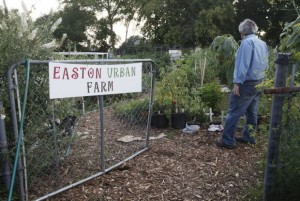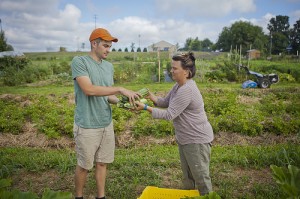Social Context
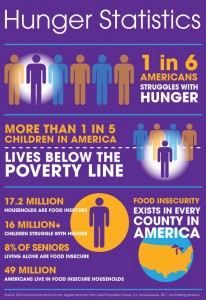 Hunger is a problem faced by many within the United States and more specifically within the City of Easton, Pennsylvania. Calculated by the USDA Economic Research Service in 2011, over 15% of households in the United States are considered food insecure and over 23 million American live in areas that can be considered food deserts, or areas where the availability of healthy and affordable foods is often difficult. Both of these characteristics attribute to hunger within Easton.
Hunger is a problem faced by many within the United States and more specifically within the City of Easton, Pennsylvania. Calculated by the USDA Economic Research Service in 2011, over 15% of households in the United States are considered food insecure and over 23 million American live in areas that can be considered food deserts, or areas where the availability of healthy and affordable foods is often difficult. Both of these characteristics attribute to hunger within Easton.
According to a USDA report in 2010, over 133 billion pounds of food available in the U.S was accounted for as waste, all the while, it is said that 1 in 6 Americans live in hunger. There is a clear disconnect between food consumption and waste and the lack of food resources available for those in need. This disconnects and a rise in hunger awareness has led to what today is called the Food Recovery Movement.
“Fighting Waste, Feeding People”
A national effort to combat hunger and a growing awareness of daily excessive food waste, has spurred the creation of organizations such as the Food Recovery Network and Campus Kitchens. Aided by the prior development of non-profits such as Feeding America, theses organizations have one goal, and that is to retrieve food that would otherwise go to waste and distribute it to those in need. Through this redistribution of food we acknowledge concerns about hunger, resource conservation and equity, and environmental and economic cost associated with food production, distribution, and waste. Eliminating food insecurity entails not only addressing problems of immediate hunger, but also confronting the issues of food access, affordability, and sustainability.
 Feeding America, a non-profit organization started in 1979, has been a main player in the field of hunger awareness in the United States. Today the have provided the fundamental information that has been the foundation of which many food rescue programs have developed their goals and values based on. Feeding America has annually provided billions of pound of food to Americans in need through the establishment of a nationwide network of food banks. Today, Feeding America is the nations largest domestic hunger-relief organization and 2014 they developed the nation’s largest and most comprehensive study series into charitable food distribution in the U.S, Hunger in America 2014. Through a dynamic infrastructure and management Feeding America has secured food donations for millions.
Feeding America, a non-profit organization started in 1979, has been a main player in the field of hunger awareness in the United States. Today the have provided the fundamental information that has been the foundation of which many food rescue programs have developed their goals and values based on. Feeding America has annually provided billions of pound of food to Americans in need through the establishment of a nationwide network of food banks. Today, Feeding America is the nations largest domestic hunger-relief organization and 2014 they developed the nation’s largest and most comprehensive study series into charitable food distribution in the U.S, Hunger in America 2014. Through a dynamic infrastructure and management Feeding America has secured food donations for millions.
As the first of its kind, Feeding America has influenced the development of other similar organizations such as the Food Recovery Network (FRN). FRN was initially started in 2011 as concerned students at University of Maryland decided to address food issues they realized on their campus and amongst many other campuses ; “ huge amounts of leftover food from campus dining halls and sports events were being thrown away” (Foodrecoverynetwork.org, 2014). What began as three concerned students at the University of Maryland has expanded to a network of Food Recovery programs at over 95 colleges and counting.
The growth of the Food Rescue movement can be attested to the larger growth in awareness that many in the community are taking. It is a movement that has been driven by concerned students, citizens, and organizations. The goal: to address hunger issues, community collaboration issues, and essentially fill the gap between the resources we have and misuse and providing these resources to the millions who need it.
Hunger in Easton
This year marked the first Food Waste & Hunger Summit, a two day conference co-hosted by FRN and the Campus Kitchen Project. Here, student leaders convened to discuss the issues of food insecurity and gave participants a forum to learn about the issues of social justice, non-profit management, public health and fields that play dynamics roles in the causes of hunger in America.
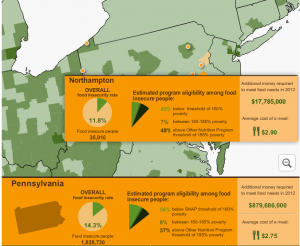
Today, issues of food justice, unemployment, local government budget cuts, and food insecurity add to the issue of hunger within the City of Easton. As a relatively small and quiet city, development in Easton has been halted over the last 10 year due the lack of economic infrastructure, and overall economic limitations of the city. In recent years the state of Pennsylvania has experienced a large spike in poverty since the recent recession. The most recent state budget contained cuts to education, healthcare, and other support services for struggling families.
Considered slightly a food desert, many of the low income residents within the city have limited access to a supermarket or fresh affordable sustainable foods. A 2009 report put out by the U.S Department of Housing and Urban Development reported that in 2009 over 23% of the population in Easton lived in poverty today that number is roughly 16%. For many of those who live in poverty, being able to provide healthy food for their family becomes one of their last priorities. This means that most families who are struggling to provide food for their families provide processed foods that provide empty calories.
Throughout the city exist many need based services with goals of providing those in the community who cannot meet daily needs with daily essentials which include shelter, food, and education. From the soup kitchens, food banks, and community centers there are limited places that provide help and food for the many citizens in need but with limited resources and minimal amount of funds, these organizations are not always able to help everyone.
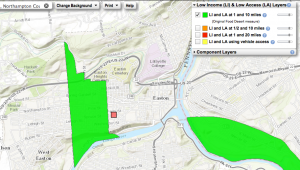
Food Justice for Easton
The lack of accessible sustainable and freshly grown foods and overall lack of resources within the city has led to the development of many community / citizen run organizations aimed at filling this “missing link, gap, or middle” in the local food infrastructure.
Hunger Coalition– As a response to hunger within the city, The Hunger Coalition is a newly developed organization that is working to support and identify long-term solutions and support systems for the hunger problem within the City of Easton. Collaborating with other local groups, agencies, and community members and nonprofit the coalition is trying to develop a way to link food supplies, educational resources, and the community. With its first community forum October 2014 the Hunger Coalition is well underway on identifying community needs, resources and trying to coordinate efforts. One of their main concerns is addressing childhood hunger and using the resources of schools and summer meals and a temporary solution.
Easton Farmers Market– Established in 1752, Easton’s Growing Farmers Market has aided in the supply of fresh and locally grown foods.“The purpose of the Easton Farmers’ Market is to provide fresh, high quality, local produce and food products directly from regional growers to the consumer.” Much of Pennsylvania’s economy depends on agricultures but a lack in the food chain and food production and distribution system makes fresh food not always easily reached.
Veggie Van- A Lafayette College student class initiative in collaboration with neighborhood partnerships worked to provide and increase access of fresh food to communities such as the West Ward. Besides the goal of providing affordable healthy foods, veggie vans goal was to show how urban area farms could make a difference.
Neighborhood Gardens and Farms- Within the community the need for fresh foods and projects like the Veggie Vans have influenced the continuous development of local farms like Lafayette College’s LaFarm and Easton’s Urban Farm.
Food Rescue Program at Lafayette
As a large stakeholder within this community, Lafayette College, located on College Hill has the ability to provide food resources to some of the local food pantries within the community. With six different dinning locations, the school could potentially provide pre-packaged or uncooked produce to local community food pantries.
Every lunch period over 300 pounds of food are prepared at the two large dinning halls on campus. Of those three hundred or some pounds, a percentage will never see it to the buffet line and instead will either be stored and reserved the next lunch period, composted, or thrown out. With the potential to provide thousands of meals annually to those less fortunate through food recovery programs, the real question becomes, why doesn’t every college in America recover food?
Taking the food and hunger issues specific to Easton into account our goal is to develop a sustainable Food Recovery program here at Lafayette that will reroute, as food programs at other schools have done, salvageable food to those in need. By analyzing the legality and policies that the school will need to consider, the cost of implementing such a program, and coming up with a plan, we believe that this program can help hundreds within the City of Easton and furthermore, it further connects us to the community. Some essential community partnerships we are currently looking into is the roll of organizations like the CACLV, the Hunger Coalition, Second Harvest, and the Easton Area Neighborhood Center.
Our program, although it is not the solution to world hunger, will allow Lafayette students and the college as a whole to take account for our actions in the environment and in this community. By implementing a food rescue program we will become a part of the larger food and hunger discussion. A food rescue program at Lafayette will be a smaller subset solution to the larger food systems issues but, the overarching goal will be to help us further embrace our social responsibility.
Developing this program and achieving our goal requires the development of a volunteer base, establishment of program guidelines, and a well-developed/defined connection and relationship with the Easton Community. How we went about establishing preliminary infrastructure for a Food Rescue program at Lafayette is covered in the following sections.
Take a look at the next section, our policy analysis, here!



